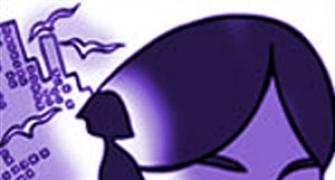The Blue Whale challenge didn't spring out of nowhere. It belongs to the well-established tradition of the glamourisation of self-harm on the internet, says Shuma Raha.

Photograph: Wikimedia Commons.
The Blue Whale challenge, the deadly online game which has so transfixed us lately, consists of 50 escalating tasks spread over 50 days, and culminates in the player taking his or her own life by jumping off a high-rise building.
In India, at least three teenagers have jumped to their deaths, fulfilling its final dare. Two others have been saved in the nick of time. And one does not know how many adolescents in this country and around the world are in thrall to it right now, cutting themselves up and growing increasingly fascinated with the idea of a spectacular suicide.
In fact, this is hardly a game. It is a lethal trap that lures vulnerable young minds and nudges them towards suicide -- its 'curators' sinister modern-day Pied Pipers leading our children to their deaths.
Terrifying as it is in its ability to prey upon teens who are given to depression and self-loathing, the Blue Whale challenge didn't just spring out of nowhere. In truth, it belongs to the storied tradition of the glamourisation of self-harm on the internet.
For years, pro-ana (websites, blogs and discussion groups for anorexic girls and women) content has not only normalised anorexic behaviour, but also influenced girls to try and attain the body shapes of emaciated 'thinspiration' models.
Graphic images of self-injury, of cutting and mutilating oneself, swirl around the internet.
In hidden social media groups, young people may feed off each other's discontent and talk about self-harm with masochistic fervour.
It becomes something to aspire to -- a dare, a challenge, a horrid solution to whatever ails the teen at that moment.
A 'challenge' is particularly appealing to an adolescent who wants self-affirmation and recognition from others.
However, most challenges that go viral on the internet, with millions posting pictures and videos of themselves pulling them off, involve serious bodily harm.
Take the 'salt and ice challenge', where youngsters pour salt on their skin and then press a cube of ice on it for as long as they can. The resultant chemical reaction plunges the temperature of the ice to -28 degrees centigrade, causing second and third degree burns.
A few years ago legions of girls were doing the 'Kylie Jenner challenge', where they sucked into a shot glass placed over their mouths. The exercise could leave them with puffed-up lips resembling those of the young reality TV star. Or it could leave them with severe cuts if the pressure caused the glass to splinter.
Other dangerous internet crazes that have consumed teenagers in the West include the 'cinnamon challenge' (swallowing a spoonful of dry ground cinnamon under a minute, which can damage the lungs) or the 'fire challenge' (pouring flammable liquids on one's body, lighting a match and basically, setting oneself on fire).
There are many studies to show that a huge number of adolescents share images of self-harm on social media and, that often, these images become the trigger for their own self-injurious behaviour.
Video: ANI.
Suicide itself is endlessly purveyed on the internet. A random Google search for 'suicide methods' throws up some 40 million results, with websites carrying names such as 'The 10 minute suicide guide' or '17 easiest painless ways of killing yourself quickly'.
Why do youngsters find self-harm, or even suicide, so cultish and attractive is a discussion for another day? The fact, however, is that the internet is a place where self-injury is often fatally romanticised, leading to a vicious cycle of more teenagers getting inspired by it.
Earlier this year, 13 Reasons Why, a teen drama on the internet-based streaming service Netflix, became a runaway hit. It depicts, in excruciating and maudlin detail, a school girl's 13 reasons for committing suicide and culminates in her slashing her wrists in a bathtub.
The show was billed as an effort to make teens with suicidal thoughts seek help. It could, in fact, have the opposite effect.
The suicide glamourises the show's young heroine, giving her the glory and respect she was denied in life. 13 Reasons Why has already caused two copycat teen suicides in the United States. In May, two school girls in Austria were saved from trying to take their own lives after watching the show.
Can youngsters be walled off from the lure of self-injury on the internet?
It's not very likely. Social media sites such as Facebook, Instagram or Tumblr now have reporting tools and filters to remove disturbing images or conversations. But they continue to crop up online and teens, who are astonishingly intuitive with their use of the internet, know exactly how to seek them out.
Hence, though the Blue Whale challenge should certainly be blocked by the authorities, don't bet on it disappearing altogether. Indeed, in the current internet ecosystem, it may even give way to frightening variants of this evil game.









